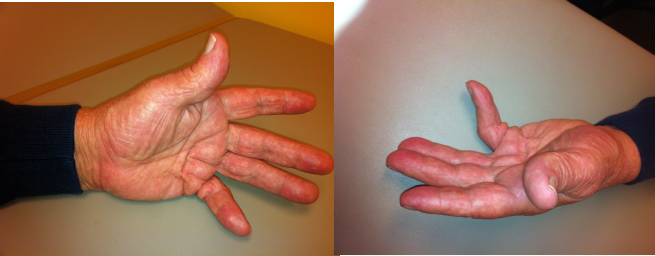







What is Dupuytren’s Contracture?
Dupuytren’s Contracture was first described by a French physician Guillaume Dupuytren
in the early 1800’s. It is a condition of the hands, affecting the palmar fascia,
a firm layer of supportive tissue under the skin of the palm. The disease creates
cords and nodules in the palmar fascia that draw or pull the fingers down. It is
usually painless, but creates a sense of tightness. It inhibits the ability of the
fingers to open fully or to place the palm flat on a surface. If mild or early, it
can be relatively harmless. But as it progresses, it can create problems with coordination
of hand function and deformity.
Examples of difficulty include awkwardness in getting the hand open enough to grasp
items, difficulty reaching into tight places like pockets, or difficulty putting
on gloves.
This condition can affect many areas of the palm and fingers, but more
often tends to affect the small and ring fingers. It frequently affects both hands,
but by no means must it be symmetric.
Dupuytren’s is a condition that gradually progresses/worsens with time and age. It is relatively uncommon in people below the age 45, although possible in severe cases. Typically, patients present with a history of the contracture developing for several years before it becomes enough of an issue to seek medical advice.
It is largely a genetically inherited disorder. There is frequently a family history in a parent, uncle or sibling. As it is a genetically carried trait, it tends to be present in certain populations. It involves whites (European ancestry) almost exclusively, but is not unheard of in other races. The vast majority of patients are men. As a tendency, women in a family may be less severely affected than the men.
While the likelihood of developing this disease is largely based on genetics, there are some risk factors that can increase the incidence or severity. Alcohol abuse, diabetes, and phenytoin (seizure drug) use have been implicated as risk factors for Dupuytren’s. To the contrary, there is no convincing evidence that certain activities or occupational exposured lead to a higher risk. Trauma to the hand has been implicated in accelerating the progression of Dupuytren’s contracture.
Unfortunately, other than controlling the aforementioned risk factors, there is no proven method of preventing Dupuytren’s disease. No topical treatments, massage, stretching , oral medications, splints or gloves have been proven to alter the progression of these contractures. While research is still ongoing, the current state of medical care is to wait until the problem has progressed sufficiently, and then initiate a treatment to correct it or diminish it.
Please refer to the treatment section of the website for a review of the latest treatment options for Dupuytren’s Contracture. Feel free to call the office at (253) 833-7750 to make an appointment to discuss your situation and get all of your questions answered.

Moderately Severe Contracture affecting small finger